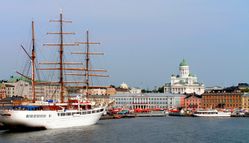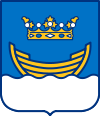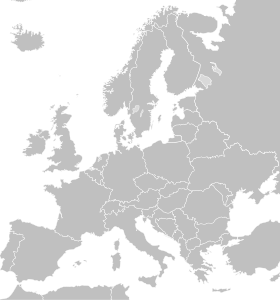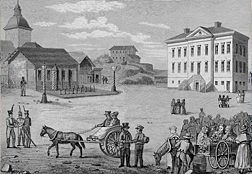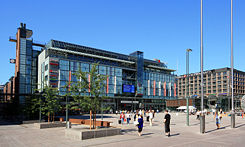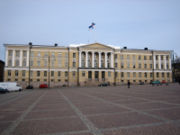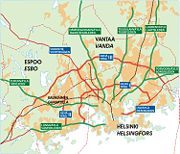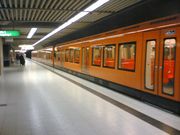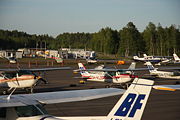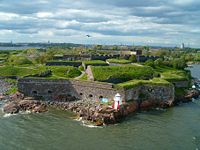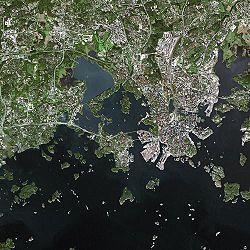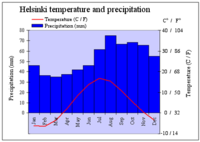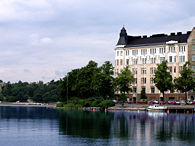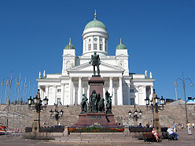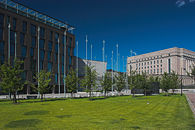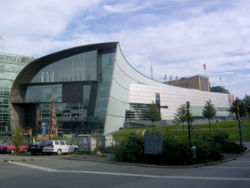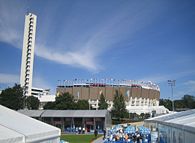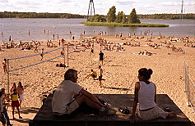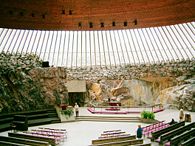Helsinki
2008/9 Schools Wikipedia Selection. Related subjects: Europe; European Cities
| City of Helsinki Helsingin kaupunki - Helsingfors stad |
|||
|
|||
| Nickname(s): Stadi, Hesa | |||
| Location of Helsinki in Europe | |||
| Coordinates: | |||
|---|---|---|---|
| Country | Finland | ||
| Province | Southern Finland | ||
| Region | Uusimaa | ||
| Sub-region | Helsinki | ||
| Charter | 1550 | ||
| Capital city | 1812 | ||
| Government | |||
| - Mayor | Jussi Pajunen | ||
| Area | |||
| - City | 187.1 km² (72.2 sq mi) | ||
| - Land | 186.4 km² (72 sq mi) | ||
| - Water | 0.7 km² (0.3 sq mi) | ||
| - Urban | 765.6 km² (295.6 sq mi) | ||
| - Metro | 3,822.2 km² (1,475.8 sq mi) | ||
| Population (2006) | |||
| - City | 569,892 | ||
| - Density | 3,060/km² (7,925.4/sq mi) | ||
| - Urban | 1 021 851 | ||
| - Urban Density | 1,330/km² (3,444.7/sq mi) | ||
| - Metro | 1 293 262 | ||
| - Metro Density | 339/km² (878/sq mi) | ||
| - Demonym | Helsinkiläinen (Finnish), Helsingforsare (Swedish), Stadilainen (slang) | ||
| Time zone | EET ( UTC+2) | ||
| - Summer ( DST) | EEST ( UTC+3) | ||
| Official languages | Finnish, Swedish | ||
| Website: www.hel.fi | |||
Helsinki (in Finnish; listen ), or Helsingfors (in Swedish; listen ) is the capital and largest city of Finland. It is in the southern part of Finland, on the shore of the Gulf of Finland, by the Baltic Sea. The population of the city of Helsinki is 569,892 ( 31 March 2008), making it the most populous municipality in Finland by a wide margin. Foreign-born population stands at around 10%.
Helsinki, along with the neighbouring cities of Vantaa, Espoo, and Kauniainen, constitutes what is known as the capital region, with over 1,000,000 inhabitants. The Greater Helsinki area contains 12 municipalities and has a population of over 1,300,000. The Greater Helsinki accounts for a quarter of population, 29% of jobs and a third of GDP.
Helsinki is Finland's capital for business, education, research, culture, and government. Greater Helsinki has eight universities and six technology parks. Some 70% of foreign companies operating in Finland have settled in Helsinki region. The immigration of rural residents has made it one of the fastest growing metropolitan areas in Europe.
Finland's main international airline hub, Helsinki-Vantaa airport is 40 minutes from the city centre, with direct flights around the world. The busy Helsinki- Tallinn route takes 1.5 hours by sea and 18 minutes by helicopter. Two other big cities in Finland, Tampere and Turku, can be reached in 1.5 - 2 hours by train and 1.5 - 2.5 hours by car.
Names and etymology
The Swedish name Helsingfors ([hɛlsiŋ'fɔʂ]) is the original name of the city of Helsinki, and is still the official Swedish name for the city. The Finnish name, Helsinki (pronounced with the stress on the first syllable: ['helsiŋki]), has been dominant in other languages for decades. The Swedish name Helsingfors comes from the name of the surrounding parish, Helsinge (source for Finnish Helsinki) and the rapids (in Swedish: fors), which flowed through the original town. It is often thought that the name Helsinge was given by the Swedish immigrants who came from the Swedish province of Hälsingland. Another explanation involves the Swedish word hals (neck), referring to the narrowest part of the river, i.e. the rapids. E.g. the names Helsingborg and Helsingör have derived from the word "hals".
In Helsinki slang the town is also called Stadi (from the Swedish word stad, meaning city) and Hesa in colloquial Finnish. Helsset is the North Sami name of Helsinki.
History
Founded in 1550 as a rival to the Hanseatic city of Reval (today: Tallinn) by King Gustav I of Sweden, the town of Helsinki struggled in its infancy. The fledgling settlement was plagued by poverty, wars, and diseases. For a long time it remained a small coastal town, overshadowed by the more thriving trade centers in the Baltic region. The construction of the Sveaborg (In Finnish Viapori, today also Suomenlinna) naval fortress helped improve its status, but it was not until Russia defeated Sweden in the Finnish War and annexed Finland as the autonomous Grand Duchy of Finland in 1809 that Helsinki began to develop into a major city.
In order to reduce Swedish influence in Finland, Czar Alexander I of Russia moved the capital from Turku, which had close ties to Sweden, to Helsinki. The Royal Academy of Turku, back then the only university in the country, was relocated to Helsinki in 1827 and eventually became the modern University of Helsinki. The move consolidated the city's new role, and the following decades saw unprecedented growth and development for the city, creating the prerequisites for the birth of the modern world class capital in the 20th century. This transformation is highly apparent in the downtown core, which was rebuilt in neoclassical style to resemble St. Petersburg. As elsewhere, technological advancements such as railroads and industrialization were a key factor behind the growth.
In the 1918 Finnish Civil War, Helsinki fell to the Red Guard on January 28th, the first day of the war. The Red side gained contol of the whole of southern Finland after minor hostilities. The Senate was relocated to Vaasa, although some senators and officials remained in hiding in the capital. After the tide of war turned against the Red forces, German troops fighting on the side of the Finnish White Guard recaptured Helsinki in April 1918. Unlike Tampere, Helsinki suffered relatively little damage in the war. After the White victory many former Red soldiers and collaborators were confined in prison camps across the country. The largest camp, having approximately 13,300 prisoners, was located on the former naval fortress island of Suomenlinna in Helsinki. Although the civil war left a considerable scar on the society, the standard of living in the country and the city began to improve in the following decade. Renowned architects such as Eliel Saarinen created utopistic plans for Helsinki, but they were never realized to full extent.
In the aerial bombings of the Winter War (1939-40) and the Continuation War (1941-44) Helsinki was attacked by Soviet bombers. The most intense air raids took place in the spring of 1944, when over two thousand Soviet planes dropped some 16,000 bombs in and around the city. However, due to successful air defense the city was spared from the large-scale destruction that many other cities in Europe under bombings of similar scale suffered. Only a small number of bombs hit populated areas.
Despite the tumultous first half of the 20th century, Helsinki continued to develop steadily. The rapid urbanization of the 1970s, which occurred relatively late in the European context, tripled the population in the metropolitan area, making the Helsinki metropolitan area one of the fastest growing urban centers in the European Union in the 1990s. The relatively sparse population density of Helsinki and its peculiar structure have often been attributed to the lateness of the urbanisation. Thus today the Helsinki metropolitan area is the second most sparsely populated EU-capital after Brussels.
Economy
The Helsinki metropolitan area generates approximately one third of the Finnish GDP. GDP per capita is roughly 1.5 times the national average, making Helsinki one of the wealthiest capitals in Europe. In 2004, the local economy grew by 3.2%.
Since the 1950s, the economy has become largely service-based, although industries such as shipbuilding continue to employ a substantial number of people. Large service-based employers include the public sector and the information technology sector. Helsinki has many staffing agencies.
The metropolitan area is the location of choice for the headquarters of large Finnish companies as well as the regional headquarters of international companies. Metropolitan area has the best availability of highly skilled employees, good infrastructure, and business ecosystem.
Helsinki has rich neighborhoods and poor neighborhoods all over the municipality. Poor neighborhoods especially in eastern areas are famous for crime and other ills. Some have preferred Espoo, which is considered better managed economy. Helsinki is also losing companies to Espoo. Improving the economy of Helsinki and cooperation between the municipalities of Helsinki conurbation area are seen as major future challenges for the economic development of the region.
Helsinki's population growth has been flat in recent years, while Espoo and surrounding areas grow clearly faster. Migration rate to Greater Helsinki is around 5000 persons per year. The fastest growing area is countryside belt between Ingå, Kirkkonummi, Vihti and Nurmijärvi and Pornainen, though absolute numbers were in hundreds between 2000-2004. Between 2000-2004, net migration in Helsinki was negative at -330 residents. 20-30 years old make around 19 percent of the population in Helsinki compared to 14 percent in Finland.
The tap water is excellent quality and it is supplied by 120km long Päijänne Water Tunnel, the world's longest continuous rock tunnel. The bottled tap water is even sold to countries such as Saudi Arabia.
Jobs
Metropolitan employment rate stands at around 75% and employment growth has been good. Around 20% works in manufacturing and construction, compared to 10% in London and 30% in Milan. In private-sector services the distribution is typical. 34.5 works in trade, 17% in transport, 8% in hotels and restaurants, 5.7 in financial services, and 34.5% in other market services.
Metropolitan gross value-added per capita is 200% of the mean of 27 European metropolitan. It equals to Stockholm or Paris. The gross value-added annual growth has been around 4%.
83 of the 100 largest companies are headquartered in Greater Helsinki. Two thirds of the 200 highest-paid executives live in Greater Helsinki and 84 in Helsinki. The average income of the top 50 earners was 1.65 million euro.
Housing
In 2004, there were 311,617 dwellings and 92,5 occupancy rate. 85.7% of dwellings were blocks of flats. Around 25% of dwellings were 1 room, 55% 2-3 rooms and 20% over 4 rooms. Home ownership was 40% in Helsinki and 60% in Finland. The average space per person is 33,5 square meters. In 2005, the average housing cost in Helsinki was 2,000 euro per square meter. The average monthly rent was around 13 euro per square meter. 2,546 new dwellings were built in 2005.
Helsinki opposes high-rise developments (buildings over 12 floors). Sometimes museum agencies restrict new developments. Santahamina is a relatively large military-occupied island just a few kilometers from the center. Because of ideological reasons, Helsinki uses taxpayer money to locate unemployed housing and drug users clinics even in the expensive city centre, despite far cheaper alternatives. On the other hand, the Centre Party decentralization programs - that move state offices to the Centre Party's rural constituencies - have angered state employees.
Demographics
The population of Helsinki is predominantly Finnish with a sizable Swedish speaking minority (6.2%) . Additionally, 5.9% of the population are foreign citizens.
The city has Finland's largest immigrant population in both absolute and relative terms. There are people from over 130 nationalities residents in Helsinki. The largest groups, in terms of smaller minorities, are from Russia, Estonia, Sweden but also from Somalia, Serbia, China, Iraq and Germany.
Services
Education
Helsinki has 190 comprehensive schools, 41 upper secondary schools and 15 vocational institutes. Half of the 41 upper secondary schools are private or state-owned, the other half municipal. Higher level education is given in eight universities (see the section "Universities" below) and four polytechnics.
Institutions of higher education
Universities
- University of Helsinki
- Helsinki University of Technology (located in neighbouring Espoo)
- Helsinki School of Economics
- Swedish School of Economics and Business Administration
- Academy of Fine Arts
- Sibelius Academy
- Theatre Academy
- University of Art and Design Helsinki
- National Defence College
Polytechnics
- Helsinki Polytechnic Stadia
- Helsinki Polytechnic Arcada
- Helsinki Business Polytechnic (Helia)
Transport
Roads
Helsinki has several ring roads: Kehä I, Kehä II, and Kehä III. From central city to east and west, there are Itäväylä and Länsiväylä. From the central city to north, there are several routes. There is a proposal to build a Stockholm-like tunnel under the central Helsinki to hide cars from streets. Central Helsinki has popular underground parking facilities.
Helsinki has some 390 cars per 1000 inhabitants. This is less than in cities of similar density, for instance, Brussel's 483 per 1000 and Stockholm's 401, and Oslo's 413.
Rail transport and buses
Public transportation is generally a hotly debated subject in the local politics of Helsinki. In Helsinki, public transportation is mostly managed under Helsinki City Transport, the city's transportation authority. The diverse public transport system consists of trams, light commuter rail, the subway, bus lines and two ferry lines. The Helsinki Metropolitan Area Council manages traffic to the surrounding municipalities of Espoo, Vantaa and Kauniainen.
Today, Helsinki is the only city in Finland to have trams or subway trains. There used to be two other cities in Finland with trams: Turku and Viipuri (Vyborg, now in Russia), but both have since abandoned trams. The Helsinki Metro, opened in the year 1982, is so far the only subway system in Finland. In 2006, the construction of the long debated extension of the subway system west into Espoo was approved, and serious debate about an eastern extension into Sipoo has taken place.
Aviation
Air traffic is handled primarily from the international Helsinki-Vantaa Airport, located approximately 19 kilometres (12 mi) north of Helsinki's downtown area, in the neighbouring city of Vantaa. The airport provides scheduled non-stop flights to many important cities in Europe, Asia and North America. Helsinki's second airport, Malmi Airport, is mainly used for general and private aviation.
Sea transport
Ferry connections to Tallinn and Stockholm are serviced by various companies. Finnlines passenger-freight ferries to Travemünde, Germany are also available, while Tallink began service to Rostock, Germany in 2007. Copterline has provided fast (18 min.) helicopter flights to Tallinn.
Politics
Helsinki has eighty-five members in its city council. The three largest parties are National Coalition (25), Social Democrats (21) and Greens (17).
Geography
Helsinki spreads around a number of bays and peninsulas and over a number of islands. The inner city area occupies a southern peninsula, which is rarely referred to by its actual name Vironniemi. Population density in certain parts of Helsinki's inner city area is very high, reaching 16,494 inhabitants per square kilometer (42,719/sq mi) in the district of Kallio, but as a whole Helsinki's population density of 3,050 inhabitants per square kilometer (7,899/sq mi) ranks it as quite sparsely populated in comparison to other European capital cities. Much of Helsinki outside the inner city area consists of postwar suburbs separated from each other by patches of forests. A narrow, ten kilometer (6.2 mi) long Helsinki Central Park that stretches from the inner city to the northern border of Helsinki is an important recreational area for the residents.
Some notable islands in Helsinki include Seurasaari, Lauttasaari and Korkeasaari – which is also the country's biggest zoo – as well as the fortress island of Suomenlinna (Sveaborg) and the military island of Santahamina.
Climate
The city has a temperate continental climate. Owing to the mitigating influence of the Baltic sea and Gulf stream, temperatures in winter are much higher than the northern location might suggest, with the average in January and February around -6 °C. Temperatures below -20 °C occur normally only for a week or two in a year. However, because of the latitude, days lasts less than six hours in the winter solstice, and the very cloudy weather accentuates the darkness. Conversely, Helsinki enjoys long days in summer, eighteen hours at the summer solstice. The temperature June through August is around 18-25 °C.
Climate in 2007 in Helsinki city centre (summer temperatures are not very hot and winter temperatures not very cold because of its location near the sea):
|
Table Climate of Helsinki |
||||||||||||||
|---|---|---|---|---|---|---|---|---|---|---|---|---|---|---|
| Temperature | ||||||||||||||
| Month | Jan | Feb | Mar | Apr | May | Jun | Jul | Aug | Sep | Oct | Nov | Dec | Year | |
| Record High°C | 9 | 12 | 17 | 25 | 30 | 31 | 33 | 31 | 26 | 19 | 13 | 10 | 33.1 | |
| Average high °C | 2 | -5 | 8 | 11 | 16 | 21 | 22 | 23 | 15 | 10 | 3 | 4 | 11 | |
| Average low °C | -6 | -14 | -1 | 0 | 5 | 9 | 13 | 12 | 6 | 3 | -2 | 0 | 2 | |
| Record low °C | -34 | -32 | -28 | -17 | -8 | -2 | 3 | -1 | -7 | -16 | -23 | -32 | -34.3 | |
| Precipitation | ||||||||||||||
| Month | Jan | Feb | Mar | Apr | May | Jun | Jul | Aug | Sep | Oct | Nov | Dec | ||
| Total mm | 78 | 11.9 | 25 | 47.2 | 46.7 | 44.4 | 60 | 61 | 76 | 91 | 86.2 | 91.4 | 718.8 | |
Architecture
Carl Ludvig Engel (1778-1840) designed several neo-classical buildings in Helsinki. He was kept in Helsinki by a unique assignment, as he was elected to plan a new city centre all on his own. The city became shallow and wide at the time when most buildings had only two or three floors. The central point of Engel's city plan is the Senate Square, surrounded by the Government's Palace, the main building of the University, and the enormous Cathedral, which was finished in 1852, twelve years after C. L. Engel's death. Engels' neo-classical plan of the city centre has later given Helsinki the epithet The White City Of The North.
Helsinki is, however, perhaps even more famous for its numerous Art Nouveau (Jugend in Finnish) buildings, designed in the early 1900s and strongly influenced by the Kalevala, which is a very popular theme in the national romantic art of that era. Helsinki's Art Nouveau style is also featured in large residential areas such as Katajanokka and Ullanlinna. The master of the Finnish Art Nouveau was Eliel Saarinen (1873-1950), whose architectural masterpiece was the Helsinki central railway station.
Helsinki also features several buildings by the world-renowned Finnish architect Alvar Aalto (1898-1976), attributed as one of the pioneers in functionalism. Many of Aalto's works are either loved or hated. Aalto's buildings, such as the headquarters of the paper company Enso and the concert and congress house Finlandia Hall, have sparked much debate amongst Helsinki's inhabitants.
In addition to Aalto's work, there is a body of other noteworthy functionalist architecture in Helsinki, such as the Olympic Stadium, the Tennis Palace, the Rowing Stadium, the Swimming Stadium, the Velodrome, the Glass Palace, the Exhibition Hall (now Töölö Sports Hall) and Helsinki-Malmi Airport. The sports venues were built to serve the 1940 Helsinki Olympic Games (canceled due to the Second World War), but eventually got to fulfill their purpose in the 1952 Olympic Games. Many of them are listed by DoCoMoMo as significant examples of modern architecture. The Olympic Stadium and Helsinki-Malmi Airport are in addition catalogued by the National Board of Antiquities as cultural-historical environments of national significance.
During the 1960s and 1970s many aesthetically and historically important houses were swiftly demolished to make room for the rapidly expanding city and instead houses presenting more values of functionalism were built. This has later been widely regarded as a bad move and has led to a strong protectionism of old buildings in Helsinki. The plans made during the era of rapid growth expected Helsinki to have well over one million inhabitants at the turn of the millennium. Much due to the strong protectionism of today there are still many areas left with distinctive old wooden houses, such as Käpylä, Kumpula, Toukola and Puu-Vallila.
As a historical footnote, Helsinki's neoclassical buildings were often used as a backdrop for scenes set to take place in the Soviet Union in many Cold War era Hollywood movies. Some of the more notable ones are The Kremlin Letter (1970), Reds (1981) and Gorky Park (1983). Because some of the streetscapes were reminiscent of Leningrad's and Moscow's old buildings, they were used in the production - much to some residents' dismay. At the same time the government secretly briefed its white-collar workers to make producing these, often clearly Soviet-negative, films in Helsinki as hard as possible due to diplomatic pressure from Moscow.
Culture
The biggest historical museum in Helsinki is the National Museum of Finland, which displays a vast historical collection from prehistoric times to the 21st century. The museum building itself, a national romantic style neo-medieval castle, is a tourist attraction. Other major historical museum is the Helsinki City Museum, which introduces visitors to Helsinki's 500 year history. The University of Helsinki also has many significant museums, including the University Museum and the Natural History Museum.
The Finnish National Gallery consists on three museums: Ateneum Art Museum for classical Finnish art, Sinebrychoff Art Museum for classical European art, and Kiasma Art Museum for modern art. The old Ateneum, a neo-renaissance palace from 19th century, is one of the city's major historical buildings, whereas the highly modern Kiasma is probably the most debated building in Helsinki.
Helsinki has three major theatres: The Finnish National Theatre, the Helsinki City Theatre, and the Finland Swedish Svenska Teatern. The city's main musical venues are the Finnish National Opera and the Finlandia concert-hall. Bigger concerts and events are usually held at one of the city's two big ice hockey arenas: the Hartwall Areena or the Helsingin Jäähalli. Helsinki has Finland's largest fair centre.
Helsinki is considered as one of the main hubs of popular music in Northern Europe, many widely renowned and acclaimed bands have originated in Helsinki, including Norther, Ensiferum, HIM, The Rasmus, The 69 Eyes, Hanoi Rocks, Apocalyptica and Stratovarius.
Events
- The Helsinki Festival is an annual arts and culture festival, which takes place every August (including the Night of the Arts).
- Valon Voimat "Forces of Light" is an annual winter arts festival.
- Vappu "Vappu" is an annual carnival for students and workers.
Helsinki hosted the Eurovision Song Contest 2007, the first ever Eurovision Song Contest arranged in Finland.
| Preceded by Athens, Greece 2006 |
Eurovision Song Contest Hosts Helsinki 2007 |
Succeeded by Belgrade, Serbia 2008 |
Sports
Helsinki has a long tradition of sports, the city gained much of its initial international recognition during the 1952 Summer Olympics, and the city has since then been very open to arranging sporting events. Helsinki hosts fairly successful local teams in both of the most popular team-sports in Finland, football and ice hockey. The latter being a sport of passion for many Helsinkians, who usually take a stance for either of the local clubs HIFK or Jokerit. The strong culture of ice hockey has led to Helsinki becoming the birthplace of many legendary National Hockey League stars such as Teemu Selänne, Jari Kurri and Esa Tikkanen. Helsinki also houses HJK, Finland's largest and most successful football club.
Tourism
Helsinki is relatively small and intimate but lively and bustling. The nearby islands are its summer delights.
Because Helsinki is located on the coast of the Baltic Sea and has many kilometres of coastline, most of its central districts are near the seaside. Helsinki is a very maritime city and is popularly called the daughter of the Baltic.
Helsinki's coastal position makes it ideal to experience in the summertime from one of the many sightseeing ferries leaving from the port of Helsinki. Many of Helsinki's main attractions are also related to the sea, including the Suomenlinna naval fortress (a UNESCO World Heritage site) and the Seurasaari Island with its parks and open-air museum. Locals often spend sunny days at the Hietaniemi beach (often simply called Hietsu), Helsinki's main beach in the district of Töölö.
In the winter-time Helsinki's northern position makes it dark for most of the day, thus making it a cosy town with much interesting lighting, such as the classic Aleksanterinkatu's Christmas street (Joulukatu). During the coldest months of the winter it is very common for Helsinkians to go for walks on the frozen sea, although much caution must be taken. There are also many places for ice swimming along the coast, some with saunas.
Air travel to Helsinki is via the Helsinki-Vantaa Airport, situated in the neighbouring town of Vantaa, a town part of Greater Helsinki. Helsinki also has popular cruiseferry links with Stockholm, Sweden and hydrofoil and catamaran links to Tallinn, Estonia. Silja, Viking and Tallink are the biggest ferry operators.
Helsinki is also the home of the Linnanmäki amusement park, which features five rollercoasters and many other rides, including the world's first Intamin ZacSpin rollercoaster, set to open April 2007.
Helsinki is a safe city for tourists and a safe place to live in. In terms of personal safety, Helsinki has been named 2nd safest city in the world.
Notable natives
| Adolf Erik Nordenskiöld | 1832–1901 | scientist |
| Helene Schjerfbeck | 1862–1946 | painter |
| Artturi Ilmari Virtanen | 1895–1973 | Nobel laureate (Chemistry, 1945) |
| Ragnar Granit | 1900–1991 | Nobel laureate (Medicine, 1967) |
| Mika Waltari | 1908–1979 | author |
| Tove Jansson | 1914–2001 | author and creator of the Moomin characters |
| Georg Henrik von Wright | 1916–2003 | philosopher |
| Tarja Halonen | 1943– | President of the Republic of Finland since 2000 |
| Esa-Pekka Salonen | 1958– | conductor and composer |
| Jari Kurri | 1960– | Hockey player and hall of famer in NHL |
| Linus Torvalds | 1969– | creator of the Linux kernel |
For a more thorough list see the Wikipedia category People from Helsinki.
